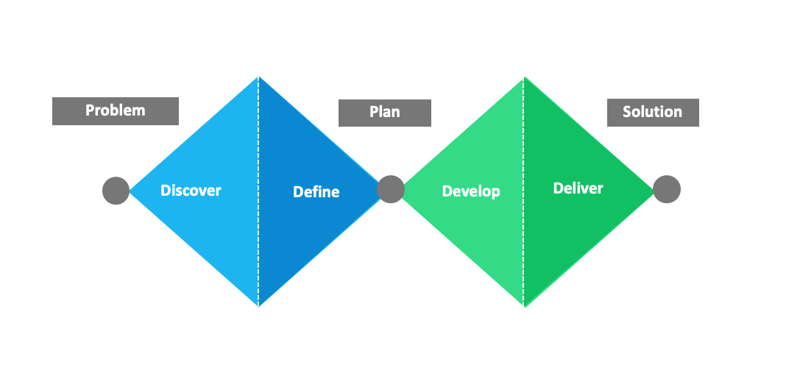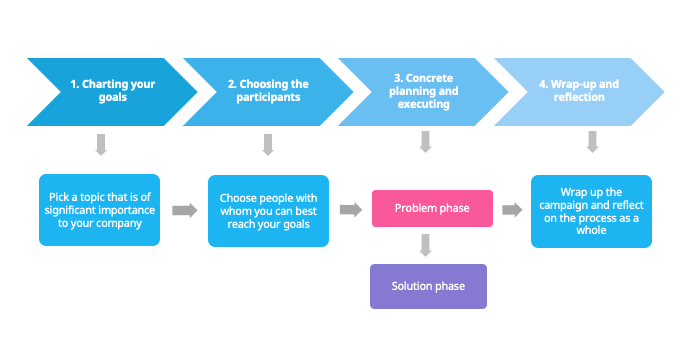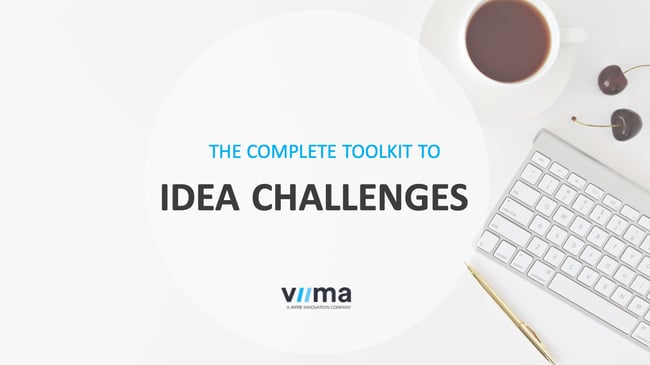The Complete Guide to Idea Challenges
What exactly is an idea challenge?
An idea challenge is a focused form of innovation where you raise a desire, concern, or area of improvement with the hopes of finding creative solutions. It typically starts off in the form of a question and is guided towards a specific audience, mandated by other preset parameters. An idea challenge is basically just a way of focusing ideation to yield the most effective of ideas and insights.
In this post, we'll teach how you can succeed in organizing one. Because this topic is quite extensive, we've put together a table of contents to help you navigate the post.
Table of contents
Now, why should you be interested in hosting an idea challenge? After all, it may initially feel like executing a successful one takes a lot of time and other valuable resources. It can even feel slightly intimidating for such a simple goal.
However, idea challenges are in fact very versatile and useful in a variety of situations. By setting different specifications and parameters, you can customize idea challenges to fit a variety of different use cases. It is, however, important to carefully consider what you aim to accomplish. A well-planned idea challenge always has a much greater chance of proving very beneficial for the company.
Ultimately, we believe that innovation and ideation should play an important role in the everyday work of most employees. For innovation to truly thrive, it is important to be persistent and commit to long-term development. Now, this is hard to achieve solely through idea challenges, which is why it’s often necessary or advisable to make idea management a continuous practice. Regardless, idea challenges can significantly boost your results in various ways.
What types of idea challenges are there?
The process of idea challenges typically follows a certain guideline called the double diamond of innovation.

The first half of this diamond is the problem phase which can be broken down into two steps called discover and define. The problem discovery consists of scouting a variety of pressing challenges and evaluating their significance. Problem definition means an analysis by the organizing team to identify recurring themes, group ideas to them to refine the problem definitions, and finally, to choose one or a few problems to initially focus on.
The second half of the diamond is the solution phase which consists of develop and deliver. Solution development means coming up with ideas and concepts for solving the aforementioned problems and further refining them into something that is ready to be implemented. Solution delivery is the final part of the solution. It basically means picking the solutions that show the most potential for actual implementation and delivery and assigning people to make them happen.

Problem-centric vs. Solution-centric
Depending on which parts of the double diamond are executed, idea challenges can be either problem-centric or solution-centric. A problem-centric idea challenge goes through the entire double diamond, first focusing on discovering and defining a problem and then finding solutions to it. A solution-centric challenge only focuses on finding solutions to an already identified problem. This problem can either be something very specific, a larger and more comprehensive topic such as increasing efficiency, or anything in between.
Different parameters
Be it a problem-centric or solution-centric challenge, there can be an almost infinite number of different kinds of idea challenges. This is due to the fact in the process of planning and running the challenge, you need to make a number of decisions that can change the nature of the challenge quite a lot.
These parameters or “variables” can be chosen quite freely to achieve the outcomes that you're looking for from the challenge. By changing the theme, audience, channels, time, or responsibilities of your idea challenge, the end result might well be very different even with the same starting point. So make sure that the challenge is as focused as possible on the goals that you're looking to accomplish.
ThemeTheme is ultimately what your entire challenge revolves around. Depending on how you choose to run the challenge, the theme could either be a problem or an opportunity. It works as your scope and focuses the conversation to the results that you're eventually looking for. A theme shouldn’t be too abstract, yet often leaving some room for creativity can lead to much better results.
Goal
Goal answers the question “What do you wish to achieve with your challenge?”. That might sound similar to the theme, but whereas theme simply means the question you wish to ask the participating people, goal is what you ultimately want to accomplish behind the curtains. It is the reason for your challenge to exist in the first place.
Audience
The audience is one of the most important variables, as it defines who exactly takes part in your idea challenge to begin with. It should be chosen with care, targeting the most relevant parties to the subject matter. It could be for example:
- Only a very specific branch or layer in an organization if only a few people have relevant knowledge for the challenge.
- Everyone inside the organization, if you need ideas in a theme that isn't too specific, or are simply interested in getting outside-the-box thinking and new insights for whatever your problem is. It often makes sense to ensure that everyone in the organization gets the opportunity to have a say, as this will make them feel that they really are a part of the shared mission, further motivating them to contribute.
- Relevant collaborators or virtual focus groups, if you'd like to have an audience that is representative of a desirable group of people, for example when ideas from outside the organization are wanted.
- The entire customer base, if you need semi-focused ideas and are looking to get input from all of the people who are actually paying your bills.
- The entire public, if you simply want ideas or opinions from the largest possible audience.
Channels
Channels are the different means of communication for talking about your idea challenge. The channel of choice answers the question: “How do I reach my audience?” Depending on the nature of your audience, it can vary all the way from social media to intranets and to personal emails and face-to-face conversations.
Time
All idea challenges are by definition time-boxed to some extent. The time parameter can be further broken down to timing of the launch and duration of the challenge. Timing of the launch simply answers the question: “When should I start my challenge?”. Duration is about the length of the challenge, as well as all the timing of the different phases within the challenge.
Responsibilities
Responsibilities include finding the appropriate parties to be in charge of running your challenge, facilitating the discussion, evaluating ideas, making decisions, as well as refining and implementing the promising ideas. In practice, this means finding the people with the right skills and the required authority for each of these roles.
Getting these variables right is a key component in launching an idea challenge that will achieve the results you were looking for. However, it is important to remember that idea challenges work best when used as focused tools for supporting continuous innovation in whatever area you want to focus on most at a given time.
What are the benefits of idea challenges?
Idea challenges are becoming increasingly popular because they let you harness the collective intelligence of hundreds or even thousands of people to focus on what matters most, which is the key to effectiveness. It is a way of gathering collective creative input to find solutions to very specific matters. These matters can vary all the way from complex strategic problems to simple enhancements to existing processes. For example, a common use for idea challenges is to rally the entire organization around a strategic goal to focus on implementing it across all levels of the company. The three key benefits of idea challenges have to do with: time, effectiveness, and communication.
Time
Imagine the everyday work that goes on in any large enterprise. From middle management to leadership, people tend to be stretched for time. There are always things to plan, things to execute, and fitting innovation into this equation is often difficult, to say the least. Thus, innovation too often gets postponed in favor of current operational errands. By launching an idea campaign and harnessing the power of the crowd, you'll get lots of new ideas and have the opportunity to also refine them in a very short amount of time, without having to dedicate large teams to figure these questions out, effectively speeding up your innovation process.
Effectiveness
Innovation, especially in large companies, is often hard to organize due to there being thousands of different insights, ideas, and pieces of knowledge spread across the organization without anyone having a centralized view of them. Idea challenges are a way of guiding those ideas on the right tracks, making ideation an effective, focused effort instead of a collection of similar thoughts scattered all over the place.
Communication
Idea challenges are also an excellent mean of communication, which is always challenging in more sizeable organizations. According to a study by Timothy Devinney and his colleagues at the University of Technology Sydney, only 29% of employees in 20 major Australian corporations had a clear idea of the company’s strategic goals when asked via multiple-choice questions. Making whatever it is that you're trying to focus on actionable is a great way to ensure that people will not only know about it but also understand the goals throughout the organization.
In conclusion, idea challenges save you time and make gathering ideas for specific causes effortless. They increase transparency in the decision-making processes, which increases motivation and commitment towards the organization. This results in a better collective understanding of the "big picture" and nudges employees to execute their tasks with more effectiveness and tenacity.
When or when not to use idea challenges?
More often than not, idea challenges can be a highly effective tool for innovation. However, as with all tools, it isn't perfect for every job.
Idea challenge can be a great tool for whenever you have a need for fresh ideas and want to focus creative input on something that is of value to the company, or if you simply wish to improve communication regarding your strategic goals.
So, when is it necessarily not the most precise tool?
Even though idea challenges are very versatile, they're probably not worth the effort if the theme of the challenge limits the number of potential participants to a few highly qualified professionals. In addition, if you simply don't have the resources to plan and execute one properly, or if the timing isn't right, for example due to a big deadline or a holiday season, it's best to at least postpone the challenge.

The step-by-step guide to launching a successful idea challenge
So, now that we have covered the basics, how does one actually make it happen?
We can break the actual process down to five key steps. These steps will walk you through the process and will remind you to take the most important factors into consideration.
1. Picking a theme and setting your goals
The primary function of this first step is to end up with an understanding of what it is you wish to achieve with the idea challenge. Even though it might sound obvious, you should really start off by prioritizing different agendas and then choose the theme that ends up first on your list. Focus and strategic fit are essential for being able to run a successful idea challenge.
Now, after you have a theme in mind, what kind of innovation are you specifically looking for? Usually this means either finding a solution to a specific problem or just generating outside-the-box ideas without very specific guidelines. An electronics company looking for a cost-efficient way to fix a faulty product is an example of a very specific problem, whereas if a clothing store wanted ideas for a brave fashion statement, they would probably want ideas from both ends of the spectrum.
Regardless of what kind of solutions you’re looking for, it’s important that you have at least one quantifiable goal. This gives you something concrete to aim for and creates a baseline on which to compare your results. For example, Pixar’s Notes Day, an inspired initiative to cut costs, had an underlying quantifiable goal of lowering production costs by 20%. You should ideally keep this goal within reach but still make it difficult enough so that not quite reaching this goal could still result in the idea challenge being considered very useful. In addition to these quantifiable results, there are also some aspects, like employee engagement, which are much harder to quantify but can be just as important in the long run.
Especially in the beginning of the planning process, it’s very important to be realistic, even critical, regarding your goals. Can this goal, in its current form, be achieved with an idea challenge? If you feel like this goal is too specific or otherwise unachievable through an idea challenge, can it be molded, rephrased or reimagined so that it is more achievable or is this simply the wrong method for solving the problem?
Is your goal a part of a long-term agenda or is it just a one-time deal? Idea challenges are very convenient for finding creative and focused solutions to individual problems, but can just as well be used for boosting innovation in themes that you're working on continuously.
2. Choosing the participants
When it comes to mapping the best possible audience for your challenge, there are three key factors that should be taken into account:
- Relevance: The qualities of an individual that represents the audience, such as: Ability to legitimately contribute, being interested in the subject matter, and being well informed on the matter.
- Size: The amount of people that take part in the challenge.
- Reachability: The likelyhood that a focus group can be reached by your means of communication
The main point here is to find the right balance between these three dimensions. You need to approach this situation by figuring out what your requirements are for an optimal audience. For a very focused theme, such as “how to develop a more energy-efficient microchip,” you probably want participants who are thoroughly informed on the subject matter, whereas for something more vague, such as “how to increase productivity at work,” just about anyone can have a groundbreaking idea.
What makes an individual relevant for your challenge ultimately depends on your theme and goals.
When it comes to audience size, you shouldn't obsess about the numbers too much. Depending on what your goal is, as long as the required amount of input is met, even a handful of participants can be more than adequate for achieving it. However, if you don’t have a large enough audience to get the input your goal requires, you should reconsider the situation.
Finally, you need to make sure that your audience can be reached. Even if you have an otherwise perfect audience in mind, if you have no way of realistically getting in contact with them, they cannot contribute to your challenge. As this factor can easily work as a bottleneck, it shouldn't be quickly disregarded.
If you fall short of finding the kind of audience that satisfies all three dimensions, you can always revisit your goals, or reconsider your requirements for the relevance of the audience. Are you certain that people without the qualifications couldn't contribute? Often the best ideas that lead to breakthroughts can come from people who aren't locked into a specific mindset but bring in completely different points of view.
3. Planning the execution
Now that you have found an appropriate audience, it’s time to look at the rest of the parameters that you still need to consider to actually make the challenge happen. These will always vary a bit depending on the nature of your challenge but some of the commonly used ones are time, channels, and responsibilities.
When it comes to the time parameter, the duration of the challenge can vary quite a lot depending on what kind of solutions you’re looking for. For very specific problems, a challenge of a rather short fixed time period, such as a single week, works well. For a more abstract or a well-structured challenge with multiple phases, you need to keep the challenge running for longer. Having said that, it's usually best to try to keep the challenge as short as possible while still giving busy people enough time to react in each of the phases.
The timing of the launch should be strategically adjusted to avoid anything that might steal the attention of your audience, such as other large events, important deadlines or the holiday season.
Channels of communication are important to make sure that participants are in the know. You should communicate significant news, keep up the enthusiasm and send reminders throughout the campaign so that those who have intent to participate don’t accidentally forget to do so.
Since your channels define how you convey most of the information to different parties of the idea challenge, they should be chosen so that you can effectively reach your audience, without making it appear like you’re spamming.
Remember to assign responsibilities firmly and vocally. Who's responsible and for what should be clear for everyone involved. At the bare minimum, someone should be responsible for general arrangements and communication regarding the challenge, someone should be responsible for evaluating the ideas and deciding which ones to progress after the challenge, and someone should be responsible for facilitating the discussion throughout the challenge in order to keep people engaged and ask them questions that will help them further refine their ideas.
A shared responsibility too often turns out to be no one’s responsibility.
It's often a good idea to also reward participants by giving responsibility. When enthusiastic participants are given more responsibility in the areas that they're passionate about, the results are usually better across the board.
Assigning responsibility is a natural step towards ensuring that promising ideas actually end up getting refined and implemented. Remember, it's usually only after an idea has been implemented that it creates value for the organization.
4. Launch and run the challenge
Now that you’ve planned the frame for the challenge, it’s time to actually execute it. However, a successful launch doesn’t just happen by pressing a button. A well organized launch is extremely important for the success of the challenge.
The launch is all about commitment and proactiveness. As long as people in charge are clear on their responsibilities, communication is by far the most important factor for success. You need to be crystal clear about the following four key points and repeat them as often as you need for the points to really hit home.
- What is it about? Make sure the audience truly understands the core of the challenge; namely the theme and the goals.
- Why do things a certain way? The “why" is just as important as the “what”. Once veryone understands why the goal is to be met through this kind of an idea challenge, they're much more likely to buy in.
- How should they operate? Make your expectations clear for people. Once they know what to do, it's simply a matter of finding motivation.
- Why should they participate? To ensure that people participate actively, it’s crucial that you've been able to figure out how to motivate people to take part in the “mission”. Intrinsic factors usually work best in the long run. Figure out why people should care about the grand vision for your challenge and don't forget to tell what kind of opportunities and rewards this could provide for the participants on a personal level.
As mentioned, if you just have the answers for these questions and communicate them well enough for people to really get them, you’re bound to succeed.
5. Wrap-up
Once your challenge has come to an end, it’s finally time to wrap things up. This is the phase where you collect the data and information gathered during the challenge and process them. You should do this right after the challenge has ended while you still have everything in fresh memory.
Rounding up the findings
Start by rounding up and analyzing the data that was gathered during the challenge. This means the ideas, observations, insights and all other notable findings. The key is to come up with actionable findings from the data.
Planning the next steps and assigning responsibilities
To make things actionable, you need to plan the next steps for promising ideas and to assign responsibilities for executing these steps. As mentioned, it’s often good to have the people who worked on the ideas during the challenge involved. Especially the person who came up with the original concept might still have valuable input, which they have not yet shared. Don't overplan and try to move as fast as possible to ensure that those who worked on the idea during the challenge are still passionate about it.
Communicate the next steps for the whole community
In addition to just executing the next steps, you should be prepared to communicate them to everyone involved in the challenge, not just the people who they've been assigned to.
By doing this, you'll ensure that people feel that their efforts have made a difference and are much more likely to participate in the future. If the challenge is for your employees, this communication is key for continuing to build a more open and engaged company culture.
Follow up
Even though the challenge itself is over, your work isn't done just yet. To make sure the ideas are actually implemented, make sure the appropriate parties have the resources they need to make the ideas a reality and follow up to let the teams know you have their backs. This will increase everyone’s motivation and also reduce the risk of the inevitable setbacks from becoming roadblocks.
Reflection
Once you’ve finally completed the challenge, it’s time to stop for a moment and reflect on it as a whole. Sit down and ask yourself and your team: what went well and where could we have done better? Did we achieve our goals or did we fall short of them? Which factors resulted in positive or negative outcomes?
Taking a moment to reflect on the challenge helps you clarify your thoughts and get a better understanding on what to improve regarding future challenges. Again, make sure to come up with action points for the things that you learned in the process.

Key success factors for idea challenges
Ultimately a good idea challenge is the result of thorough understanding of what you wish to achieve and how to achieve it. In our experience, there are five factors that are crucial for being able to succeed with your challenge.
- The right audience. People who are able to legitimately contribute should be both, interested in the subject matter and at least partially informed on it. This will increase the rate of participation and yield knowledgeable input.
- The right time for your launch. It is good to be aware of the factors competing for the attention of your audience. Choose a time when there aren't too many other things going on for your audience. It's hardly the best time to launch the challenge during a holiday or just before a big deadline!
- Motivation. People usually need some incentive to participate. These can vary from monetary to intrinsic, with the latter, such as getting recognition or a chance for promotion, usually working better in the long run. Monetary incentives tend to have at best a fleeting effect on motivation, whereas intrinsic ones build commitment for the right reasons.
- Having a good tool, where most of the action happens, is a must. This tool should be fun and easy to use, as well as effortlessly accessible from everywhere to ensure active participation. The platform should also have proper support for the ideation process, as well as enable transparent communication. For continued success, launching a new idea challenge should also be quick and easy.
- Continuous interaction is vital in terms of keeping the participants interested, motivated and informed. The primary focus of interaction should be in the form of constructive feedback and encouragement for the participants. This will result in higher levels of activity and better quality of ideas. If you don't interact, are too blunt or critical, or simply don't react fast enough to ideas and questions, participants are much more likely to drop out during the challenge.
Let's make it happen!
If you're interested in running your very own idea challenge, feel free to download our Idea Challenge Toolkit. The Toolkit consists of:
1. Slide templates for planning the process and communicating about it
2. Email templates that further help you communicate the right points
3. A modifiable copy of the Idea Challenge Canvas for planning the challenge
IDEA CHALLENGE CANVAS
And, don't forget to subscribe for updates on our upcoming articles!






